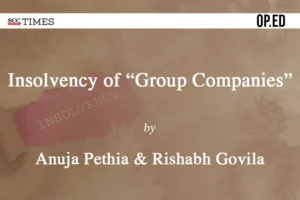“Too soon to introduce” is how the “Report of the Insolvency Law Committee”1 dated 26-3-2018 described group insolvency. However, in 2019, National Company Law Tribunal (NCLT) decided that it was not that soon to “tackle the bull by the horns”. Thus, came the concept of “group insolvency” in India.
The foundation of group insolvency was laid down by the NCLT in SBI v. Videocon Industries Ltd.2 in 2019. A consortium of banks led by the State Bank of India, moved a petition before NCLT, Mumbai, asking for substantial consolidation of the group of 15 companies under the “Videocon Group”, which was undergoing separate corporate insolvency resolution processes (CIRPs).
Before coming to the specifics of what was laid down in Videocon case3, let us understand what is meant by “group insolvency”. Sometimes, companies are separate legal entities, but they have a unity of interest and ownership. For example, Tata Motors and Tata Steel are two separate companies which form part of the Tata Group.
Let us assume that both the Tata companies go into CIRP, and two different resolution professionals are appointed to take the process forward. However, there are so many cross holdings between these two companies that they cannot function independently. If CIRP starts separately, it will be far less efficient than a collective and common CIRP of both these companies. This “common CIRP” is known as “group insolvency”.
In Videocon case4, NCLT laid down the law pertaining to consolidation of CIRPs. NCLT held that while there is no single yardstick on the basis of which a motion for consolidation can or cannot be approved, there are some checks and parameters which can be put into place.
NCLT held that first a preliminary inquiry has to be done to determine whether consolidation yields benefit to stakeholders by offsetting the harm caused by non-consolidation. NCLT set out a list of examples, which can lead to a decisive conclusion of triggering consolidation of CIRP. Some of these factors are:
-
Common control: Whether the companies have a common set of promoters?
-
Common directors: Whether the group companies have any common directors?
-
Common assets: Are there assets which show interdependency for example one company has leased its land to another group company?
-
Interdependence: Whether their survival is interdependent — such as one company is a manufacturer and another trader of the manufactured products?
-
Common liabilities and interlacing of finance: Whether the companies file common consolidated financial statements? Whether they have taken common loans?
-
Singleness of economics of units: Whether they have a common brand identity?
-
Other factors: Whether they have common financial creditors and interloped debts? How much do the members of Committee of Creditors (CoC) overlap?
NCLT further held that a consolidation request can be denied if equity favours debtor separateness. The burden to prove the same is on the party that is objecting to consolidation of CIRP. If consolidation of CIRPs is allowed, then NCLT can direct that the assets of all corporate debtors are pooled together. NCLT can also direct a common resolution professional to be appointed for all corporate debtors; a common CoC be constituted. The CIRP commencement date can be universalised for all corporate debtors. The principle being that NCLT can take steps which maximise the value of assets of the corporate debtors as well as steps which promote efficiency and speedy completion of CIRP.
Much of the success of group insolvency will depend on how decisive and bold NCLTs are in taking decisions to remove peculiar issues that crop up in almost every CIRP. Whether it was too soon to introduce or not — only time will tell.
*Advocate. Author can be reached at: anuja.pethia@swarnimlegal.com.
**Advocate. Author can be reached at: govilarishabh@swarnimlegal.com.
1. Ministry of Corporate Affairs, Government of India, Report of the Insolvency Law Committee (2018).

